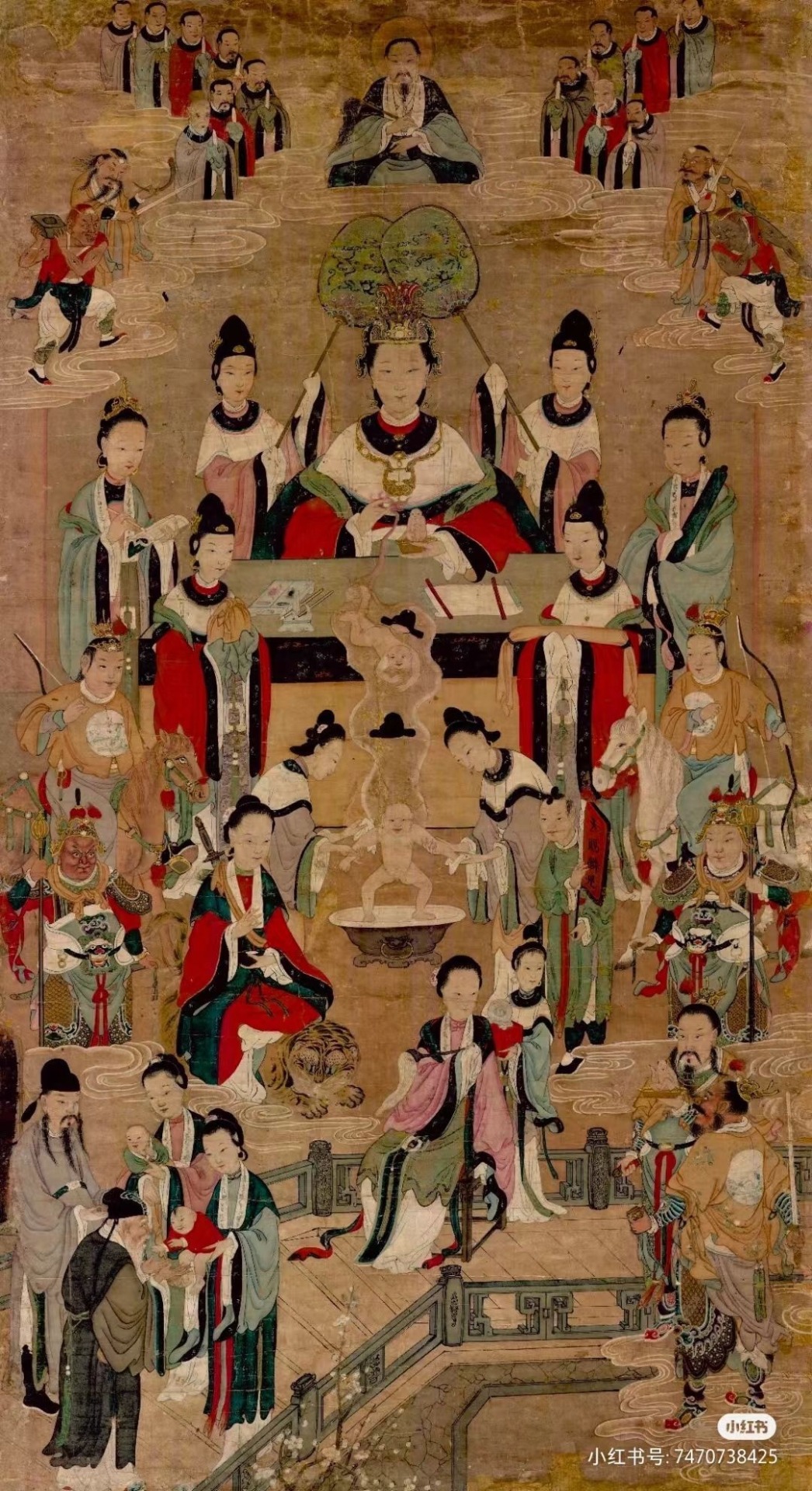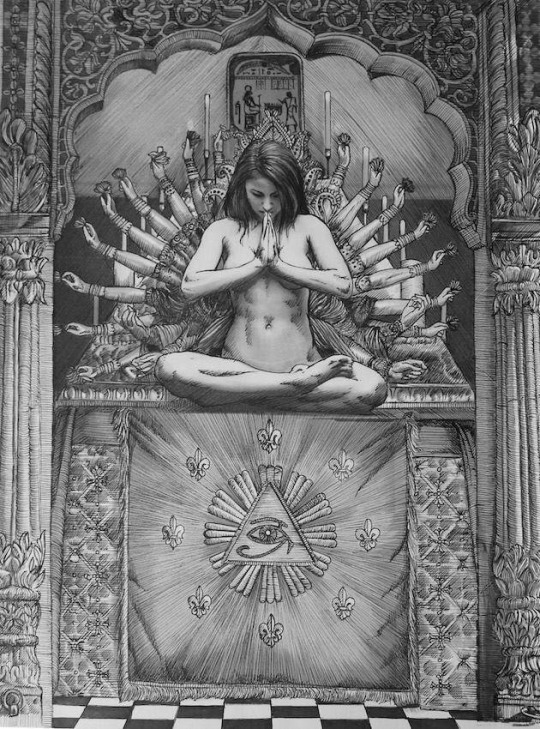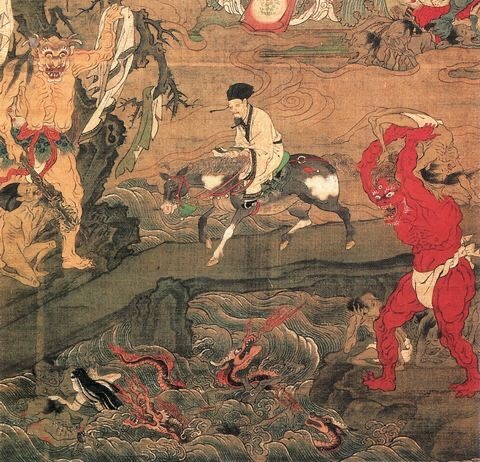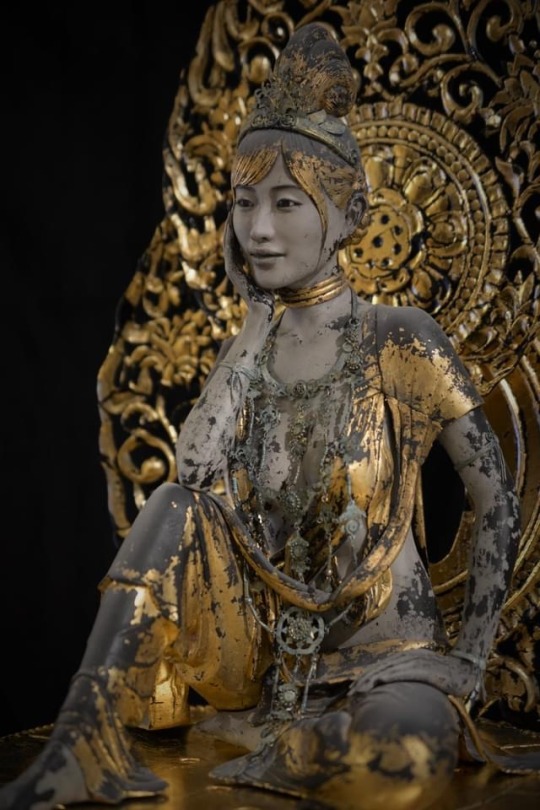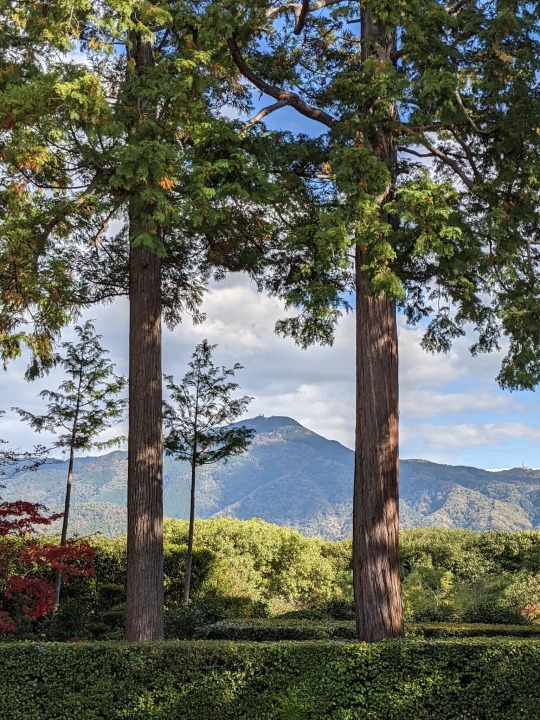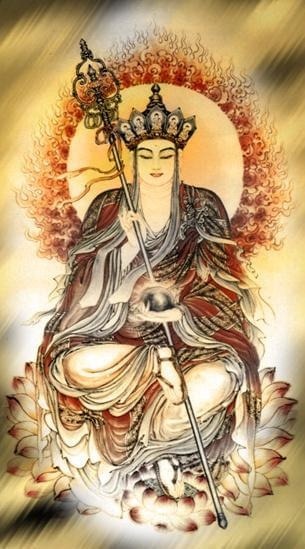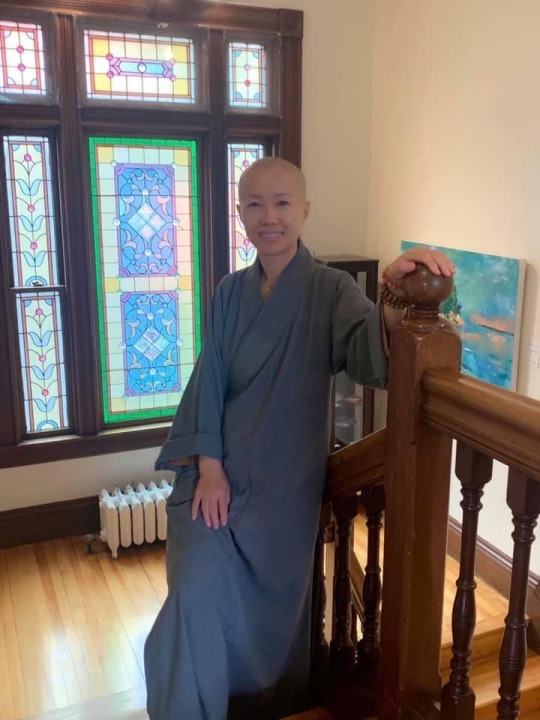Text
"Monasticism is critical for the future of Buddhism in America. There is a tendency in American Buddhism not to think so, and to argue that monasticism was appropriate in Asian society but not in America, where most practitioners are bound to be lay practitioners. The idea that we don’t really need monasticism here is very wrong. The source of it is an unwitting Protestant ethic that is unwilling to have people pursuing a life path that doesn’t involve producing things. But in fact, one of our problems is that we overproduce things and it would be good to have a lot of people who are not producing things."
~ Professor Robert A.F. Thurman
0 notes
Photo

Divine Sakura Daibutsu, Japan. Photography by yukkey
@yukkey_inc
424 notes
·
View notes
Photo
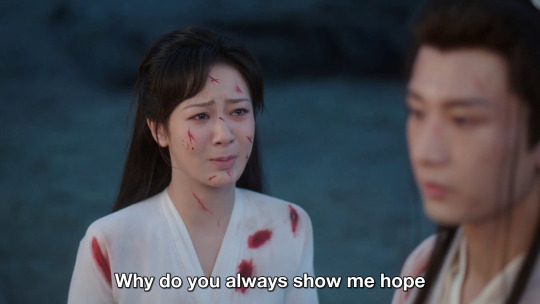
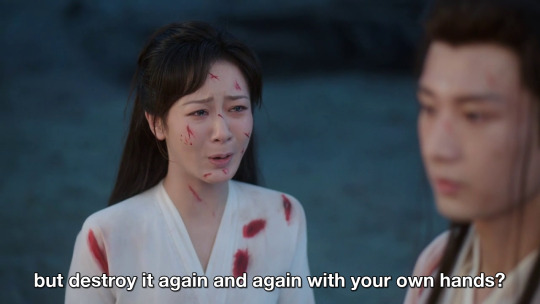

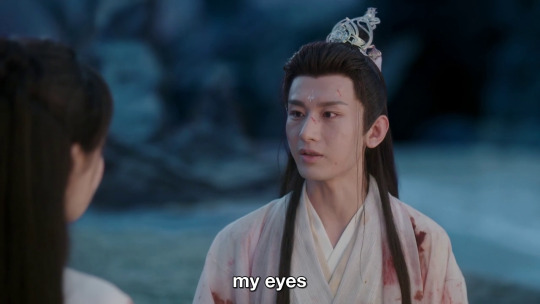
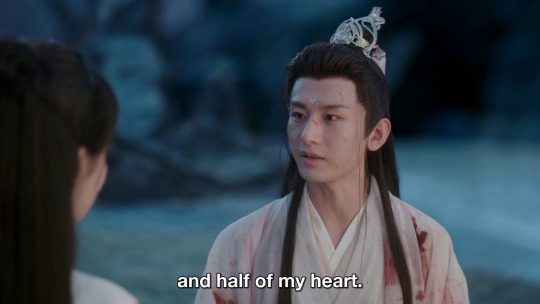
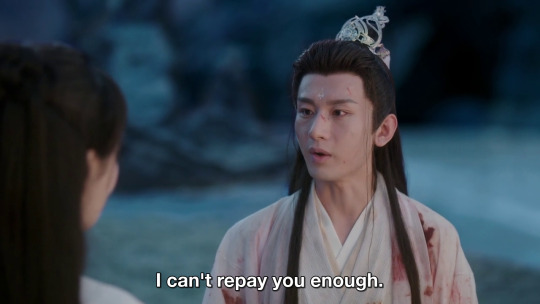
And she finally gives up because if he knows everything and still doesn’t love her…well.
DELICIOUSNESS, YOU TELL HIM!!!!






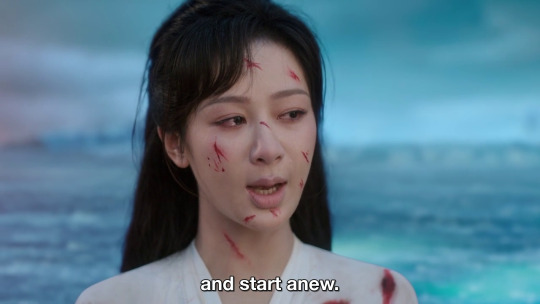
31 notes
·
View notes
Photo
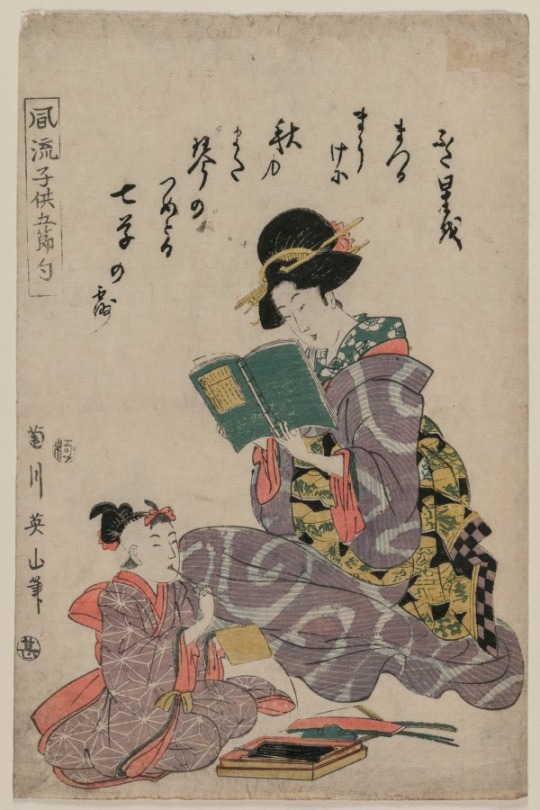
Girl Reading a Book, Kikugawa Eizan, 1787-1867, Cleveland Museum of Art: Japanese Art
Size: Sheet: 35.3 x 23.1 cm (13 7/8 x 9 1/8 in.)
Medium: color woodblock print
https://clevelandart.org/art/1943.32
34 notes
·
View notes
Text


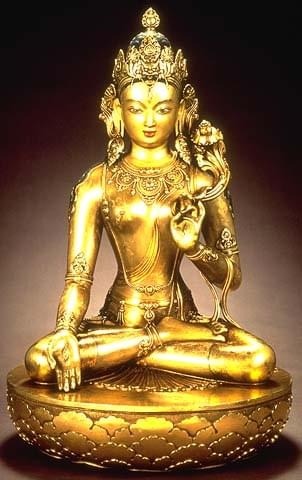
White Tara Long Life Prayer And Blessings
White Tara long life Mantra
Om Tare Tuttare Ture Mama Ayuh Punya Jnana Pustim Kuru Svaha.
Om - Representing the union of mind, body, and spirit that is at the heart of yoga.
Tare – This syllable shows that Mother Tara liberates sentient beings from samsara.
Tuttare – Liberates you from the eight fears related to the external dangers. However, the main dangers come from attachment, ignorance, anger, pride, miserliness, jealousy, doubt and wrong views.
Ture – This syllable liberates you from the disease.
Mama - Mine, means that I would like to possess the following qualities.
Ayuh - Long life
Punya - Merit that comes form living life ethically.
Jnana - Wisdom
Pustim - Abundance” or ”an increase in wealth.
Kuru - Do so! do it now!
Svaha - Hail, or may blessings be upon
This is a beautiful layered mantra calling on White Tara for her Divine Love, compassion, wisdom and protection.The White Tara (Sanskrit: Sitatara; Tibetan: Sgrol-dkar) She symbolizes purity and is often represented standing at the right hand of her consort, Avalokiteshvara, or seated with legs crossed, holding a full-blown lotus. She is generally shown with a third eye.
Tara, Tibetan Sgrol-MA, Buddhist saviour-goddess with numerous forms, widely popular in Nepal, Tibet, and Mongolia. She is the feminine counterpart of the Bodhisattva (“Buddha-to-be”) Avalokiteshvara. According to popular belief, she came into existence from a tear of Avalokiteshvara, which fell to the ground and formed a lake.
Out of its waters rose up a lotus, which, on opening, revealed the goddess. Like Avalokiteshvara, she is a compassionate, succoring deity who helps men “cross to the other shore.” She is the protectress of navigation and earthly travel, as well as of spiritual travel along the path to enlightenment.
White Tara is the female Bodhisattva of compassionate activity, the supreme mother and collective manifestation of the enlightened activity of all the Buddhas. She is said to see all suffering and respond to requests for help. Her yogic method promotes health and extending one's lifespan.
White Tara is a Bodhisattva (one who has pledged to put the suffering of others before her own release from suffering) who encompasses the characteristics of all Buddha’s past, present, and future.White Tara is known by Tibetan Buddhists as The Swift Protectress because Tara acts quickly to protect the mind from the delusions and snares of Samsara. She is also known as Samaya Tara, translating as ”Vow Tara.”
This refers to Tara’s vow to save all sentient beings. Occasionally, White Tara is called “the Mother of all Buddhas”, because She represents the perfect embodiment of graceful power, purity, and wisdom. The main characteristic of Arya Tara is that she is....
For details, please visit :
https://bit.ly/3luOH2x
To watch and listen to White Tara prayer, this is our Youtube channel as follow:
https://youtu.be/vqIJZPpJE9Q
Thank you for reading, may you find peace and great bliss. With your support it helps to spread the Buddha’s precious teachings and turning the Dharma wheels in the world.
Aspiration For Bodhichitta
For those in whom the precious Bodhichitta has not arisen
May it arise and not decrease
But increase further and further.
Dedication of Merit
By this merit may we obtain omniscience then.
Having defeated the enemies wrong-doings.
May we liberate migratory from the ocean of existence.
With its stormy waves of birth, old age, sickness and death.
*Note
I do not own or infringe any copyright of the picture(s).
Picture(s) courtesy and credit to the rightful distributors and or studios.
Picture(s) is/are intended for editorial use only.
1 note
·
View note
Text
Daily Pratice Yamanthaka

༄༅། །འཇམ་དཔལ་གཤིན་རྗེའི་རྒྱུན་ཁྱེར་བཞུགས།
A Daily Practice of Mañjuśrī Yamāntaka
by Jamyang Khyentse Chökyi Lodrö
སྐྱབས་སེམས་སྔོན་དུ་འགྲོ་བས།
With refuge and bodhicitta as a preliminary, recite the following:
ཨྱཻ། ཨེ་ཉིད་སྟོང་པ་ཆོས་འབྱུང་སྟེ། །
ayai, é nyi tongpa chöjung té
Ayai! From the dharmadhātu, the empty space of É as such,
མ་སྐྱེས་འགགས་པ་མེད་པ་ལས། །
makyé gakpa mepa lé
Which is unborn and does not cease,
རང་བཞིན་གནས་པ་དྲན་པར་བྱ། །
rangshyin nepa drenpar ja
I bring to mind that which is naturally present:
ཨཻ་ཡི་ཕོ་བྲང་ཆེན་པོའི་ནང་། །
ai yi podrang chenpö nang
Within the great palace of Ai,
རྒྱུ་དང་རྐྱེན་ལས་མ་བསྐྱེད་པར། །
gyu dang kyen lé makyepar
Not created through causes and conditions,
ཀླུ་གཉན་ས་བདག་རུ་ཏྲ་དང་། །
lunyen sadak rudra dang
Mañjuśrī arises out of awareness, like a fish leaping from water,
མ་ཧེ་ཉི་ཟླ་པདྨའི་སྟེང་། །
mahé nyida pemé teng
In a form of overwhelming splendour,
རིག་པ་ཆུ་ལས་ཉ་འཕར་ཚུལ། །
rigpa chu lé nya par tsul
And standing upon nāgas, nyen, earth lords, rudras,
འཇམ་དཔལ་ཕྱག་རྒྱ་ཟིལ་གྱིས་གནོན། །
jampal chakgya zil gyi nön
Buffaloes, sun, moon and lotus.
དབུ་གསུམ་ཕྱག་དྲུག་ཞབས་བཞི་བསྒྲད། །
u sum chak druk shyab shyi dré
He has three faces, six arms and four striding feet,
གཡས་དཀར་གཡོན་དམར་དབུས་མཐིང་ཞལ། །
yé kar yön mar ü ting shyal
The right face is white, the left face red, and the central face blue.
འཁོར་ལོ་རལ་གྲི་རྡོ་རྗེ་གཡས། །
khorlo raldri dorjé yé
In his right hands he holds a wheel, sword and vajra;
བེ་ཅོན་གཏུན་ཤིང་སྡིག་མཛུབ་གཡོན། །
bechön tün shing dik dzub yön
With his left hands he holds a club and wooden pestle and makes a threatening mudrā.
རིགས་ལྔའི་ཁྲོ་བོས་དབུ་ལ་བརྒྱན། །
rik ngé trowö u la gyen
The wrathful ones of the five families adorn his crown
དཔལ་གྱི་ཆས་རྫོགས་དུར་ཁྲོད་བརྒྱན། །
pal gyi ché dzok durtrö gyen
And he has all the glorious attributes and ornaments of the charnel ground.
ཡུམ་ནི་གཉིས་མེད་ཆོས་ཀྱི་དབྱིངས། །
yum ni nyimé chö kyi ying
His consort, indivisible within the dharmadhātu,
མཐིང་ནག་ཙིཏྟ་བྷན་དམར་སྟོབས། །
tingnak tsitta bhen mar tob
Is dark blue and proffers a heart and blood-filled skullcup.
སྤྲུལ་པ་རྒྱན་གྱི་ལྷ་བརྒྱད་དང་། །
trulpa gyen gyi lha gyé dang
As emanations, the eight deities of adornment
ཡེ་ཤེས་ཁྲོ་བོ་བཅུ་རྣམས་རྫོགས། །
yeshe trowo chu nam dzok
And the ten of wisdom wrath are all present.
སྤྲུལ་པའི་ཁྲོ་ཚོགས་དཔག་མེད་དང་། །
trulpé tro tsok pakmé dang
The deities emanate countless wrathful hosts
རྡོ་རྗེའི་ཚྭ་ཚྭ་རབ་ཏུ་འཕྲོ། །
dorjé tsatsa rabtu tro
And an effusion of vajra sparks.
སྣང་ལ་རང་བཞིན་མེད་པར་བསྒོམ། །
nang la rangshyin mepar gom
Visualize them all as appearing yet unreal.
ཐུགས་ཀར་ཉི་སྟེང་ཧཱུྃ་གི་མཐར། །
tukkar nyi teng hung gi tar
Upon a sun at Yamāntaka’s heart,
སྔགས་ཀྱི་ཕྲེང་བས་བསྐོར་བ་ལས། །
ngak kyi trengwé korwa lé
The mantra garland revolves around a syllable Hūṃ,
འོད་ཟེར་སྤྲོ་བསྡུས་དོན་གཉིས་བྱས། །
özer trodü dön nyi jé
Emitting and absorbing rays of light to fulfil the twofold aims.
སྣང་སྲིད་ཐམས་ཅད་དཔལ་ཆེན་པོའི། །
nangsi tamché palchenpö
All appearance and existence arises as the wisdom intent
ལྷ་སྔགས་དབྱེར་མེད་དགོངས་པར་ཤར། །
lha ngak yermé gongpar shar
In which deity and mantra of the Great Awesome One are indivisible.
ཨོཾ་ཨཱ་ཀྲོ་ཏེ་ཀ་ཡ་མཱནྟ་ཀ་ཧ་ན་མ་ཐ་བྷཉྫ་ཧཱུྃ་ཕཊ༔
om a trotéka yamantaka hana mata bhandza hung pé
oṃ āḥ krodhika yamāntaka hana matha bhañja hūṃ phaṭ
ཞེས་སྤྱི་བསྙེན་བཟླའོ། །
Recite this general approach mantra.
ཐུན་མཐར།
At the end of the session, conclude with:
ལྷར་སྣང་འོད་གསལ་དབྱིངས་སུ་ཐིམ། །
lhar nangö sal ying su tim
The deity’s appearance dissolves into the sphere of luminosity.
སླར་ཡང་ཟིལ་གནོན་སྐུ་རུ་ལྡང་། །
lar yang zilnön ku ru dang
Then arises once again in the form of overwhelming splendour.
བཛྲ་ཀཱ་ཝཱ་ཙི་རཀྵ་ཧཾ༔
benza ka wa tsi raksha hang
Vajra kāvāci rakṣa haṃ
དགེ་བ་འདི་ཡིས་མྱུར་དུ་བདག །
gewa di yi nyurdu dak
Through the positivity and merit of this, may I swiftly
འཇམ་དཔལ་ཁྲོ་བོ་འགྲུབ་གྱུར་ནས། །
jampal trowo drub gyur né
Attain the realization of wrathful Mañjuśrī, and thereby
འགྲོ་བ་གཅིག་ཀྱང་མ་ལུས་པ། །
drowa chik kyang malüpa
Every single sentient being
དེ་ཡི་ས་ལ་འགོད་པར་ཤོག །
dé yi sa la göpar shok
Reach his state of perfection too.
སོགས་བསྔོ་སྨོན་བྱའོ། །
Dedicate the merit and recite prayers of aspiration.
ཞེས་པའང་ཆོས་ཀྱི་བློ་གྲོས་པས་བྲིས་པའོ། །། །
This was written by Chökyi Lodrö.
14 notes
·
View notes
